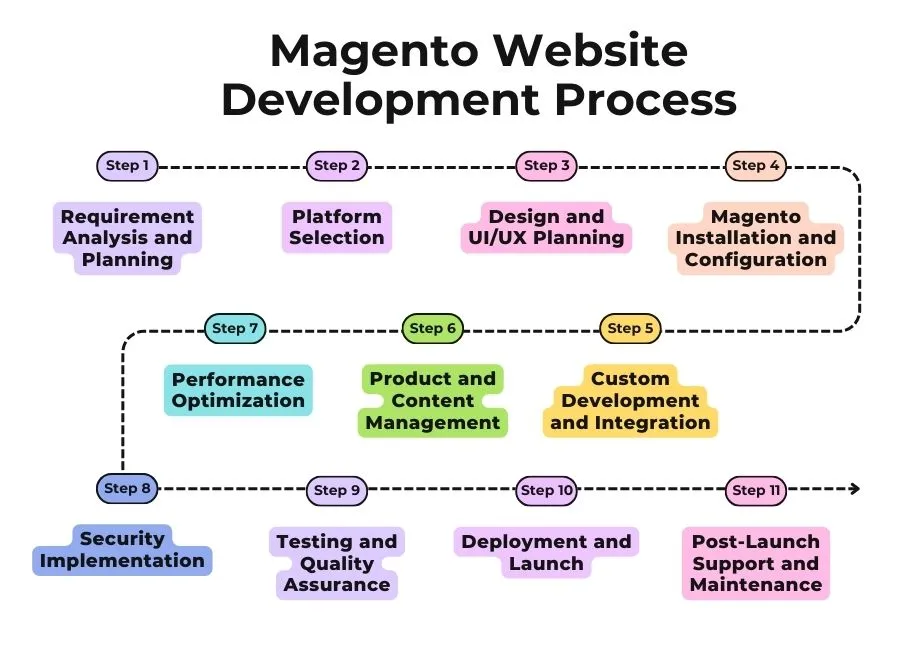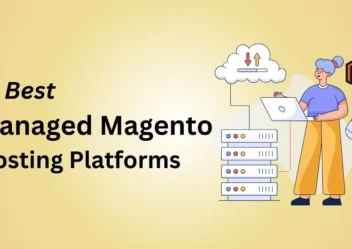Magento Web Development: How to Develop an E-commerce Site
Building a robust, scalable, user-friendly e-commerce platform is the first step toward business success. Magento is a top choice for businesses seeking high customization, performance, and flexibility.
This article explores the core aspects of Magento web development, including its key components, the step-by-step development process, and reasons why Magento is an ideal choice for eCommerce. When businesses understand these elements, they can make informed decisions and leverage Magento to build innovative, future-ready eCommerce experiences.
What Is Magento Web Development?

Magento web development is the process of creating and customizing e-commerce websites using the Magento platform. Magento is especially suitable for businesses looking to build scalable, feature-rich online stores that provide a seamless shopping experience to customers.
Magento web development for purpose product catalog management, advanced search features, secure payment integration, multi-store functionality, mobile responsiveness, and powerful SEO tools. Developers can leverage these features to build tailored e-commerce solutions that meet the unique needs of businesses, from small retailers to large enterprises.
Key Components of Magento Web Development
Magento web development has several core components that work together to build, manage, and optimize a high-performing e-commerce website.
Magento Architecture
As one of the essential components of Magento web development, the architecture underpins every aspect of building and managing a robust e-commerce platform. Here are the key aspects:
Modular Structure
Magento is built around a modular system. Based on this, developers to create, modify, or disable individual functional units (modules) without affecting the entire system.
MVC (Model-View-Controller) Framework
At its core, Magento employs the MVC design pattern. This separation of concerns means that the business logic (models), user interface (views), and control logic (controllers) are distinctly managed. The codebase is more manageable and facilitates parallel development efforts.
Service Contracts and Dependency Injection
Service contracts define clear APIs for interacting with modules so that changes in one area do not break functionality in another. Dependency injection, meanwhile, provides an efficient way to manage class dependencies, making the system more modular and testable.
Theming and Layout System
Beyond the business logic, Magento’s architecture includes a theming system. This system separates design from core functionality. Developers can create or customize themes that control the front-end experience without altering backend functionality.
Extensibility Through Plugins and Observers
Magento leverages plugins (also known as interceptors) and the observer pattern to modify or extend functionality without modifying the original code.
Database Abstraction
Magento uses an abstracted database layer, makes data interactions more streamlined, and supports multiple databases if required.
Themes and Templates
Themes control the visual presentation of a Magento store. Developers can customize pre-built themes or create unique templates to deliver a branded and user-friendly interface that enhances the customer experience.
Modules and Extensions
Modules and extensions are the building blocks that customize the platform’s functionality.
- Modules provide specific features or functions, such as product management, checkout workflows, or customer segmentation.
- Extensions are add-ons or plugins that extend the default capabilities of Magento. These can be developed in-house or sourced from third-party vendors and cover a wide range of needs — from SEO and marketing automation to advanced analytics and payment integrations.
Product and Catalog Management
Magento gives you robust tools for managing a wide range of product types, including simple, configurable, grouped, and virtual products. It supports bulk uploads, custom attributes, inventory tracking, and category organization.
Shopping Cart and Checkout System
With Magento’s shopping cart module, customers can add, edit, or remove products easily. It supports dynamic price updates, tax calculations, and multi-currency setups.
Magento’s checkout process supports one-page or multi-step checkouts, guest and registered user options, as well as multiple payment and shipping methods.
User and Customer Management
Magento streamlines customer management, user segmentation, and the assignment of roles and permissions – each of which is essential for personalizing user experiences while maintaining tight administrative control.
SEO and Marketing Tools

Magento prioritizes SEO at its core so that e-commerce businesses can achieve higher search engine visibility right out of the box.
In addition to technical SEO enhancements, Magento integrates a suite of marketing tools that directly contribute to improved SEO outcomes. Features such as promotions, coupons, and email campaign management generate user engagement signals. These marketing efforts create additional opportunities for generating quality backlinks and social shares – both of which can boost search rankings.
Security and Performance
On the security side, Magento gives us multiple layers of protection. One of the key features is CAPTCHA, which prevents spam and automated attacks by verifying that interactions on the site are made by real users. Additionally, Magento supports two-factor authentication (2FA), which adds an extra layer of login security by requiring a second verification step, such as a code sent to the user’s phone.
In terms of performance, Magento uses several advanced techniques to maintain fast and responsive websites. Full-page caching and block caching significantly reduce the load on the server by storing reusable content. Indexing is another important process in Magento – it regularly updates the database to ensure that product prices, categories, and other dynamic content are quickly retrievable, enhancing site responsiveness. Furthermore, Magento supports integration with content delivery networks (CDNs), which distribute content across global servers, reducing latency and improving site speed for users regardless of location.
Multi-store and Multilingual Support
Magento’s ability to manage multiple stores, languages, and currencies facilitates businesses to seamlessly operate in global markets without the overhead of maintaining separate systems for each region.
For instance, a company can set up distinct storefronts for various target markets – each with its own design, product catalog, pricing strategy, and promotional campaigns – while still managing all these elements from one centralized dashboard.
API Integration
Magento supports REST and SOAP APIs for seamless integration with third-party applications, including ERP, CRM, payment gateways, shipping providers, and more.
Analytics and Reporting
Built-in reporting and integration with tools like Google Analytics provide insights into customer behavior, sales performance, and marketing effectiveness, aiding in data-driven decision-making.
How to Do Magento Website Development Process?

Below are the key steps in the Magento website development process:
Step 1. Requirement Analysis and Planning
The process begins with a thorough understanding of the client’s business goals, target audience, product offerings, and technical requirements. A project plan is developed outlining the scope, timelines, resources, and budget.
Step 2. Platform Selection
Next, businesses must choose the Magento edition that best suits their needs. At this stage, you are tasked with evaluating Magento Open Source versus Adobe Commerce (formerly Magento Commerce) based on criteria such as business size, project complexity, and specific feature requirements.
Magento Open Source is ideal for small to medium-sized businesses or startups that require a flexible, customizable platform without the overhead of licensing fees. However, while it offers significant flexibility, it may require more in-house technical expertise and additional investments in extensions or custom development to meet specific business demands.
In contrast, Adobe Commerce is targeted towards larger enterprises or rapidly growing businesses that need advanced functionality and premium support. This edition handles high-traffic volumes and complex e-commerce operations, making it a more comprehensive yet costlier solution.
Step 3. Design and UI/UX Planning
Customized themes or templates are developed with the goal of bringing your brand’s personality to life. This phase involves selecting appropriate color schemes, typography, and imagery that resonate with your target audience.
The design should combine visual appeal with enhanced usability — for instance, buttons and interactive elements should be prominent and accessible, or the overall layout should adapt responsively across multiple devices.
Step 4. Magento Installation and Configuration
Set up the Magento environment, including server configuration, database setup, and Magento installation. Essential store settings such as currency, language, tax rules, and email configurations are also defined.
Step 5. Custom Development and Integration
- Theme Customization: Develop or customize the frontend theme to meet design requirements.
- Module Development: Build or install custom modules to add features beyond Magento’s core capabilities.
- Third-Party Integrations: Integrate with external systems such as payment gateways, shipping providers, ERP, CRM, and marketing tools.
Step 6. Product and Content Management
Add and configure product data, including images, descriptions, SKUs, attributes, and pricing. Organize products into categories and set up static pages such as About Us, Contact, FAQs, and Policies.
Step 7. Performance Optimization
Strengthen website speed and responsiveness through code optimization, caching (such as Varnish or Redis), image compression, and Content Delivery Network (CDN) integration.
Step 8. Security Implementation
Apply important security practices – SSL certification, reCAPTCHA, secure admin panel access, regular patch updates, and two-factor authentication to protect customer data and transactions.
Step 9. Testing and Quality Assurance
Conduct comprehensive testing – functional, performance, usability, security, and cross-browser testing – to identify and fix any bugs or issues before the site goes live.
Step 10. Deployment and Launch
Migrate the website from the development environment to the live server. Final configurations are made, and the website is officially launched for public access.
Step 11. Post-Launch Support and Maintenance
Launching a Magento store is not the end – it’s the beginning of a continuous lifecycle of optimization, support, and growth. In this step, your eCommerce platform needs to remain secure, high-performing, and aligned with customer expectations.
Why You Should Choose Magento For E-commerce Development?
Magento is one of the most powerful and widely adopted eCommerce platforms available today. Here are several professional reasons you should choose Magento for eCommerce development:
Highly Customizable and Scalable
Magento has a flexible and modular architecture. Based on that, developers can fully customize the design, functionality, and features of an online store. Whether customers are operating a small boutique or a large enterprise, Magento scales effortlessly to support business growth and increase traffic.
Feature-Rich Platform
Magento comes equipped with a comprehensive set of built-in features – product and catalog management, advanced search and filtering, multi-store management, customer segmentation, promotional tools, and a streamlined checkout process. All are essential for running a modern e-commerce business.
Superior SEO Capabilities
Magento is architected to give eCommerce businesses a powerful edge in search engine visibility. This is the factor for driving organic traffic and converting users without the constant cost of ads. With its SEO-friendly framework, developers and marketers will easily fine-tune every element of on-page optimization.
Mobile-Friendly and Responsive Design
Over 55% of eCommerce traffic now comes from mobile devices, so having a mobile-optimized site is no longer optional; it’s essential. Magento addresses this demand so your online store automatically adapts to various screen sizes and resolutions.
Moreover, Google prioritizes mobile-friendly websites in its search rankings. Magento’s mobile responsiveness makes your store meet these requirements, helping it stay competitive in search engine results.
Extensive Integration Options
Magento’s open ecosystem and wide plugin marketplace have over 3,800 extensions available to enhance and integrate store functionality. Popular integrations include:
- Payment gateways (PayPal, Stripe, Authorize.net, Braintree)
- Shipping and logistics providers (FedEx, UPS, DHL, ShipStation)
- ERP and CRM systems (Salesforce, NetSuite, SAP, Microsoft Dynamics)
- Marketing tools (Mailchimp, HubSpot, Google Tag Manager)
Strong Community and Ecosystem
One of Magento’s most powerful advantages is its thriving global community – a network of over 300,000 developers, 1,500+ solution partners, and countless contributors who are continuously driving innovation, collaboration, and improvement.
Robust Security Features
Magento places a high priority on security. It offers built-in security tools, regular patches, two-factor authentication, CAPTCHA, and SSL support to protect sensitive customer and business data.
Multi-store and Multilingual Support
With Magento, you can create different websites, stores, and store views – all operating under the same system. Each website can have its domain, customer base, and checkout flow. Each store within a website can feature different product catalogs, and each store view can reflect a different language, currency, or regional configuration.
Analytics and Reporting Tools
Magento supplies detailed reports and analytics on sales, customer behavior, and inventory, enabling data-driven decision-making and continuous business optimization.
Backed by Adobe (for Magento Commerce)
Magento Commerce is now part of Adobe, benefiting from Adobe’s innovation, stability, and integration. It is ideal for enterprises seeking a unified digital commerce platform.
Conclusion
As consumer expectations move forward and technology advances, Magento remains adaptable, embracing trends such as headless commerce, AI integration, and mobile-first experiences. However, successful Magento website development requires careful planning, the right technical expertise, and a forward-thinking approach.



